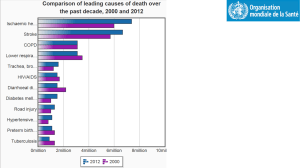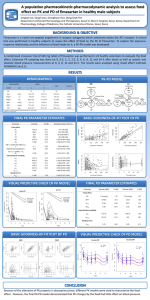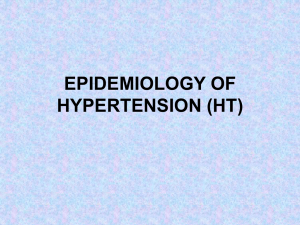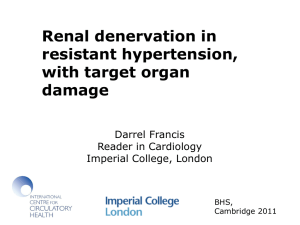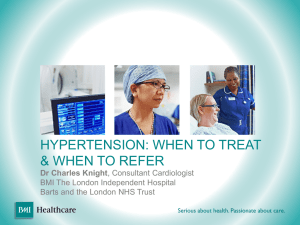12 months - Intranet
advertisement
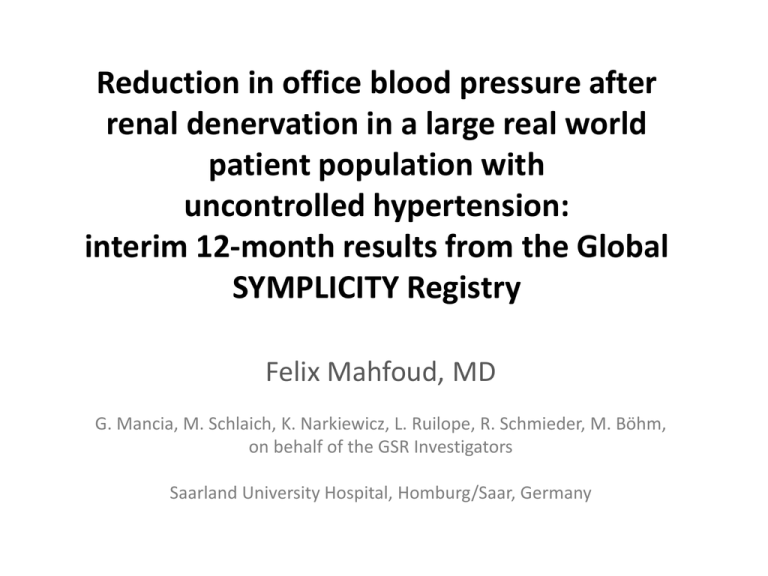
Reduction in office blood pressure after renal denervation in a large real world patient population with uncontrolled hypertension: interim 12-month results from the Global SYMPLICITY Registry Felix Mahfoud, MD G. Mancia, M. Schlaich, K. Narkiewicz, L. Ruilope, R. Schmieder, M. Böhm, on behalf of the GSR Investigators Saarland University Hospital, Homburg/Saar, Germany Potential Conflicts of Interest I have the following potential conflicts of interest to report: Research Grants • Deutsche Hochdruckliga • Deutsche Gesellschaft für Kardiologie • Saarländisches Ministerium für Wissenschaft und Forschung Consultant/Lecture fee/Travel support: • Medtronic, St. Jude, Boston Scientific, Cordis, Berlin Chemie, Boehringer Ingelheim Institutional grant/Research support: • Medtronic, St. Jude, Recor, Boston Scientific Global SYMPLICITY Registry Co-Chairs Prof. Michael Böhm; Prof. Giuseppe Mancia Executive Committee Prof. Bryan Williams; Prof. Krzysztof Narkiewicz; Prof. Luis Ruilope; Prof. Markus Schlaich; Dr. Felix Mahfoud Steering Committee Executive committee and Dr. Mostafa Adel Youssef; Dr. Ashok Seth; Brett Egan; Dr. Dong-Ju Choi; Dr. Phillip L’Allier Prof. Bert Andersson; Prof. Chaim Lotan; Prof. Iris Baumgartner; Prof. Massimo Volpe; Prof. Roland Schmieder; Prof. Thierry Lefevre; Prof. Uta Hoppe; Prof. Uwe Zeymer; Dr. Robaayah Zambahari Independent Clinical Events Committee Steven Marx, MD; Clive Rosendorff, MD, PhD; Michele H. Mokrzycki, MD; Ladan Golestaneh, MD; Joel Neugarten, MD (Non-voting members: Roxana Mehran, MD and Sorin Brener, MD) Data Analysis Institut für Herzinfarktforschung, IHF, Ludwigshafen, Germany Sponsor Deutsche Gesellschaft für Kardiologie Medtronic, Inc. Background • The Global SYMPLICITY Registry is a prospective, open label, multi-center, international registry designed to assess periprocedural and long-term safety of RDN in a real world population. • The registry will provide valuable information regarding the effect of RDN on – Blood pressure in hypertensive patients – Conditions characterized by sympathetic overdrive – Differences in patient populations treated with renal denervation • Follow-up results in the first 1,000 enrolled patients for 12 months are now available. Global SYMPLICITY Registry CA: 5 Korea: 10 WE: 116 C&EEU: 10 MEA: 11 LA: 6 ASEAN: 10 ANZ: 11 • 245 international sites in 37 countries • min. 10% randomly assigned to 100% monitoring Global SYMPLICITY Registry Inclusion criteria CA: 5 Korea: 10 WE: 116 C&EEU: 10 MEA: 11 LA: 6 ASEAN: 10 ANZ: 11 • Uncontrolled hypertension or other conditions associated with increased sympathetic activity • >18 years Global SYMPLICITY Registry Consecutive patients treated in real world population 5000 patients GREAT Registry N=1000 ✔ Korea Registry N=102 ✔ Follow-up 3M schedule 6M South Africa Registry N=400 Canada and Mexico 1Y 3Y 2Y 1,000 patients * Limited to resistant hypertension only Rest of GSR N~3500 4Y 5Y Patient Disposition Baseline (N=1000) OBP: 989/1000 (98.9%) ABPM: 692/1000 (69.2%) • 2 patients died • 2 patients withdrew 3 Month Follow-up (N=996) Safety: 984/998 (98.6%) OBP: 798/996 (80.0%) ABPM: 485/996 (48.6%) • 2 patients died • 2 patients withdrew 6 Month Follow-up (N=992) Safety: 969/996 (97.3%) OBP: 793/992 (79.9%) ABPM: 526/992 (53.0%) • 8 patients died • 15 patients withdrew 12 Month Follow-up (N=969) Safety: 862/982 (87.8%) OBP: 749/969 (77.2%) ABPM: 390/969 (40.2%) Analysis on BP change performed on patients with matching baseline and follow-up values Baseline Patient Characteristics N=1000 Gender, (male) Age (years) BMI (kg/m2) Current smoking History of cardiac disease eGFR <60 ml/min/1.73m2 61% 61 ± 12 30 ± 6 10% 51% 23% Sleep apnea (AHI≥5) 4% Diabetes, Type 2 1 co-morbidity 2 co-morbidities 3+ co-morbidities 39% 40% 36% 25% Baseline Patient Characteristics N=1000 Office BP (Systolic/Diastolic), mmHg 165/89 ± 24/16 24-h BP (Systolic/Diastolic), mmHg 154/86 ± 18/14 True hypertension 82% Masked hypertension 12% Pseudo-hypertension 5% Baseline Antihypertensive Medication Use N=1000 Antihypertensive medication classes Beta-blockers ACE inhibitors ARB CCB Diuretic Aldosterone antagonists Spironolactone 4.5 ± 1.3 79% 34% 67% 77% 79% 22% Alpha adrenergic blocker Direct-acting vasodilator 19% 35% 16% Centrally acting sympatholytics 35% Direct renin inhibitor 8% Procedural Details N=1000 Number of renal arteries 2.2 ± 0.5 Treatment time, min 50.4 ± 21.6 Number of ablations 13.5 ± 4.1 Number of 120 sec ablations 11.4 ± 3.5 Contrast volume used, cc (IQR*) *25-75% intra-quartile range 127.8 ± 81.1 (70, 160) Operator Experience in GSR • 189 operators did 1,000 procedures 70% 60% 50% 59% 59% of interventionists performed >15 RDN procedures 40% 30% 20% 10% 14% 13% 2-5 procedures 6-10 procedures 10% 4% 0% 1 procedure 11-15 procedures >15 procedures Safety at 6 and 12 Months 6 Month n=969 12 Month n=862 2.0% 3.9% Cardiovascular death* 0.2% (2) 0.8% (7) Stroke 0.8% (8) 1.3% (11) Hospitalization for new onset heart failure 0.6% (6) 1.3% (11) Hospitalization for atrial fibrillation 0.8% (8) 1.7% (15) Hospitalization for hypertensive crisis/hypertensive emergency* 0.9% (9) 1.6% (14) Myocardial infarction 0.5% (5) 1.0% (9) New onset end stage renal disease* 0.2% (3) 0.4% (3) Serum creatinine elevation > 50% 0.4% (4) 1.0% (9) New renal artery stenosis >70%* 0.0% (0) 0.2% (2) Non-cardiovascular death 0.2% (2) 0.5% (4) Renal artery re-intervention* 0.2% (2) 0.4% (3) Vascular complication* 0.5% (5) 0.6% (5) Composite safety endpoint* Cardiovascular events Renal events Post-procedural events *included in composite safety endpoint. At 1 month this is defined as Major Adverse Event (MAE) rate Change in Office SBP for All Patients and SBP Subgroups Baseline Office SBP Change in Office Systolic Blood Pressure (mm Hg) All Patients* 20 <140 mmHg* 13.0* 140-159 mmHg 160-179 mmHg ≥180 mmHg 14.5* 3 Months 11.0* 6 Months 10 12 Months n=790 n=784 n=740 n=234 n=231 n=214 n=280 n=286 n=264 n=179 n=166 n=162 0 n=97 n=101 n=100 -1.9† -10 -9.9* -20 -30 -4.7‡ -4.3‡ -11.6* -13.0* *P<0.0001 ‡P<0.05 †P=NS Error Bars=1.96 SE -13.0* -14.6* -16.3* -27.7* -31.8* -33.9* -40 Baseline SBP 164 ± 24 128 ± 10 150 ± 6 *P<0.0001 for both 3 and 6 month change from baseline (mmHg) †P=0.14 at 3 months and P=0.0006 at 6 months 167 ± 6 196 ± 14 *85% of patients in this subgroup had masked hypertension (24-h SBP>135 mmHg) Change in 24-hour SBP for All Patients and Office SBP Subgroups Baseline Office SBP Change in 24-hour mean Systolic Ambulatory Blood Pressure (mm Hg) 3 0 All Patients* n=409 n=432 n=390 <140 mmHg n=56 n=71 n=62 140-159 mmHg n=140 n=136 n=130 160-179 mmHg n=115 n=130 n=117 ≥180 mmHg n=90 n=87 n=73 -3 -6 -9 -12 -7.1 -7.9 -6.6 -8.3 -6.4 -6.8 -6.6 -6.4 -7.6 -7.8 -7.7 -9.3 -15 P<0.01 vs. Baseline for all comparisons Error Bars= 1.96 SE -18 *P<0.0001 for both 3 and 6 month change from baseline †P=0.14 at 3 months and P=0.0006 at 6 months 3 Months 6 Months 12 Months -9.0 -9.7 -10.0 Change in Office and 24-h SBP for Patients with Baseline SBP <140 mmHg Change in Systolic Blood Pressure (mm Hg) 20 15 “Masked hypertension” (24-h SBP>135 mmHg) 13.0 3 Months 14.5 11.0 12 Months 10 5 0 -5 -10 -15 6 Months Mean 24-hour Ambulatory SBP n=97 n=101 n=56 n=71 n=62 -6.4 -6.8 -6.6 n=100 Office SBP P<0.01 for all vs. Baseline Error Bars= 1.96 SE Change in Office SBP for HTN3-like Patients All patients Change in Systolic Blood Pressure (mm Hg) 0 n=784 n=740 HTN3-like patients* n=252 n=234 -5 -10 -15 -20 -11.6 ± 24.7 -13.0 ± 26.3 P<0.0001 for all vs. Baseline Error bars= 1.96 SE 6 months -25 12 months -19.3 ± 22.4 -21.5 ± 25.6 *Baseline office SBP ≥160 mmHg, mean 24-hr SBP≥135 mmHg, ≥3 antihypertensive drug classes prescribed Change in 24-h SBP for HTN3-like Patients All patients Change in Systolic Blood Pressure (mm Hg) 0 n=432 HTN3-like patients* n=390 n=55 n=64 -4 -8 -7.9 ± 17.5 -12 -8.3 ± 17.8 P<0.0001 for all vs. Baseline Error bars= 1.96 SE -16 6 months 12 months -9.5 ± 14.7 -11.4 ± 17.9 *Baseline office SBP ≥160 mmHg, mean 24-hr SBP≥135 mmHg, ≥3 antihypertensive drug classes prescribed Medication Changes at 12 months All patients Increase Decrease No change Not determined 18% (181/986) 25% (250/986) 56% (550/986) 0.5% (5/986) HTN3-like patients Increase Decrease No change Not determined 18% (59/326) 26% (84/326) 56% (181/326) 0.6% (2/326) Limitations • Patient selection was at the discretion of enrolling physicians. • As a registry follow-up procedures were not standardized and under-reporting of events is basically possible. However, an independent CEC adjudicated all protocol defined safety events potentially related to RDN. • The subset of Global SYMPLICITY registry patients matching the SYMPLICITY HTN-3 like inclusion was limited to patients in whom the BP inclusion criteria could be positively verified. Conclusions • In this "real world" patient population, patients demonstrated a substantial reduction in office and ambulatory SBP after RDN, performed by experienced operators, with a favorable safety profile. • Decreases in office and mean 24-hour SBP were greater in the subset of patients meeting the more rigorous SYMPLICITY HTN-3 enrollment criteria. • 55.6% of registry patients meeting the SYMPLICITY HTN-3 criteria achieved an office SBP <160 mmHg at 12 months and almost 23% were <140 mmHg within one year of RDN therapy. • RDN therapy resulted in significant reductions in mean 24-hour SBP in the previously undescribed subset of patients with “masked hypertension.” Thank you! Dr. Felix Mahfoud, MD Klinik für Innere Medizin III Universitätsklinikum des Saarlandes Homburg/Saar, Germany Tel. 06841-16-21346 Fax. 06841-16-13211 felix.mahfoud@uks.eu
